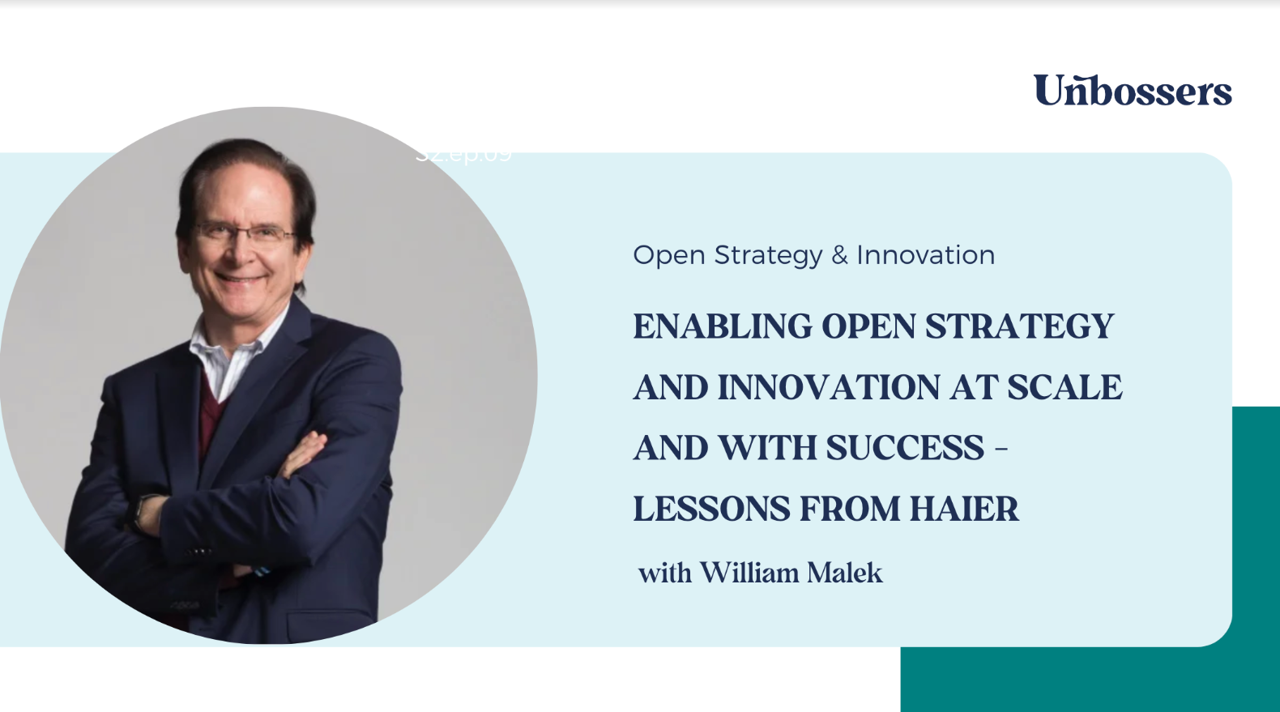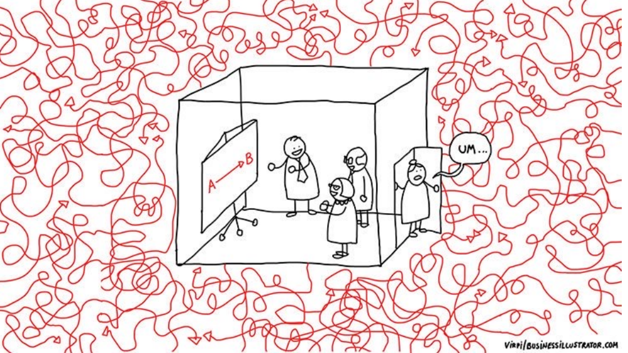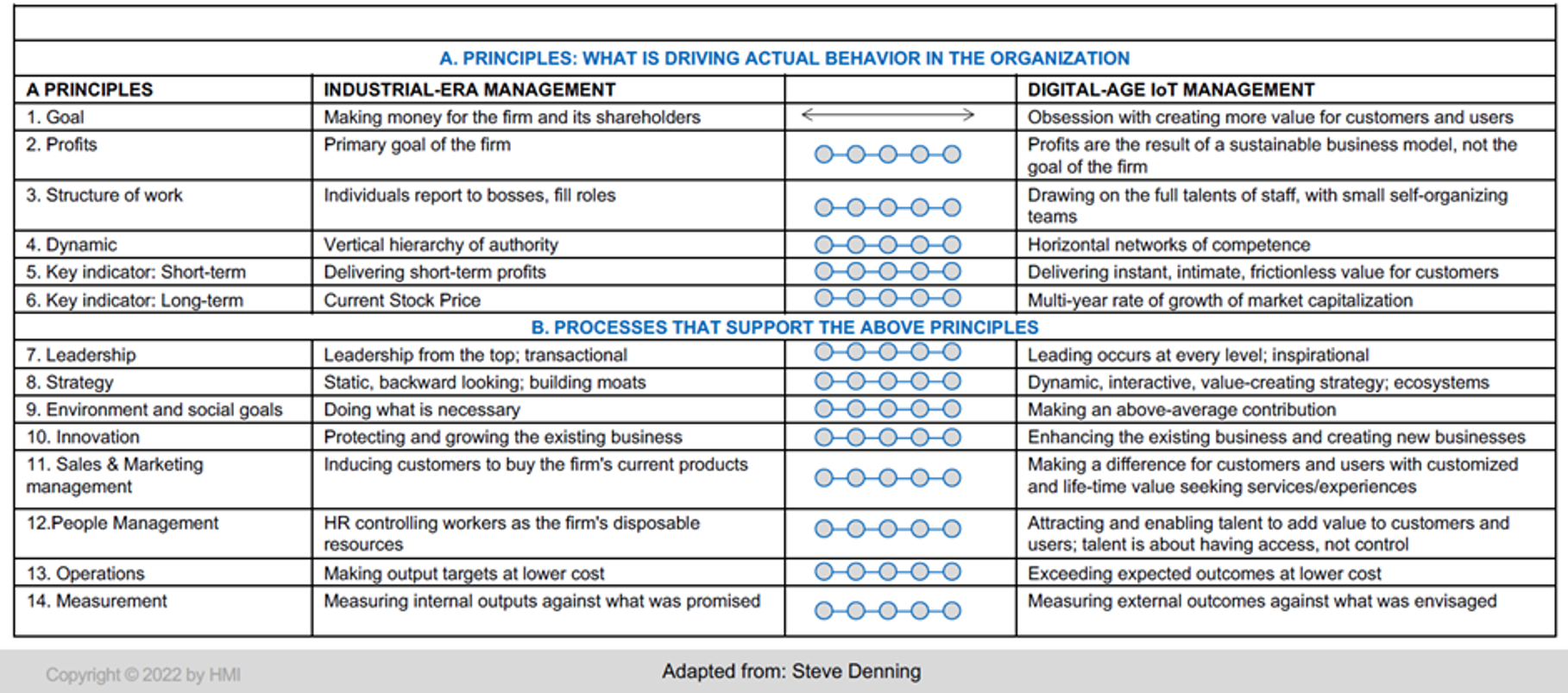#UnbossersNetwork #Customer first
Scaling Open Strategy and Innovation successfully: lessons from Haier

by Nick the Unbosser and Kris Debisschop – Unbossers Fellow
We are currently connecting 11 changemakers from well-known organizations with companies around the world that combine successful business success with deep care for people and society. This is the Unbossers Network! Embark on the incredible journey with us as we unveil the captivating tales of exceptional organizations. Brace yourself for story number 3, the one of Haier.
Some context first
Haier, a Chinese company of almost 100.000 employees, is the world’s number 1 in multiple categories:
- Digital/IoT (Internet of Things) era wellbeing solutions
- Ranked number 1 white goods manufacturer for 11 years
- Awarded by Forbes as the World’s Most Admired Company.
This 38 $ billion company has gone through a massive managerial transformation. They evolved into a decentralized networked organization and hardcore practitioners of Open Strategy at scale with these impressive results:
- 20% compounded growth annually over the past 10 years
- 22% compounded growth in gross profits
- A success rate of 49% (!) in Series A funding of innovation projects.
Our co-host in this session was William Malek. He’s the co-author of Executing your strategy, CEO of Strategy2Reality and former Program Director of Standford’s Advanced Project Management Program.
It’s thanks to William that Unbossers is an exclusive partner of the Haier Model Institute (HMI). HMI is a micro-enterprise within the Haier ecosystem, founded by former CEO Zhang Ruimin, to inspire the corporate world with its revolutionizing management model.
William is one of the most passionate proponents we know of this management model. He was more than happy to give our Unbossers Network members insights into how Haier became so successful and the vital role of Open Strategy and Innovation in their journey.
In today’s rapidly changing world, a straightforward and adaptable strategy is crucial for companies to succeed. But, how do you create a plan that not only meets challenges head-on but also garners support from everyone? Enter the power of Open Strategy!
By involving a broad range of stakeholders, from employees to competitors, companies can develop strategies that are more innovative, robust, and aligned with their values and purpose. For us Unbossers, Open Strategy is the ultimate approach to crafting a strategic process that truly works!
Here are our 6 main points from William’s webinar, along with some personal reflections:
Know why you would open your strategy-making or innovation!
Think carefully before you start opening your doors to external people when making strategy or innovation. Because we are not talking about just another management technique. It involves a fundamentally new mindset based on trust, transparency, collaboration and diversity which should be nurtured in the long term.
If you don’t have a compelling drive for adopting Open Strategy or innovation then the challenges that will emerge in implementation to oppose will attack you. Just like a body’s immune system does! Think for example of revealing (too much) sensitive strategic information with external people or secrecy issues … .
So first, sit down with your leadership team and commit together why you would open up strategy-making or innovation: to collect ideas for a new strategic direction, to foster inclusion and collaboration of different stakeholders, to increase transparency and understanding to gain external support etc..

For Zhang Ruimin, Haier’s CEO at the time, the reason for opening up was his observation that their matrix organization model had become so large and complex that:
- there was no longer a clear view on what was happening in the outside world
- they couldn’t keep up with the shift to mass customization and the need to stay ahead in innovation
- accountability was lost
That hard conclusion was the starting point for building a new operating model in which strategy emerges and evolves constantly at the edge of the organization, at the boundary, the frontline … This way, they turned a large product manufacturer into an entrepreneur breeding platform and innovation engine.
Report to the customer, not your boss
This reminds us of the following: ask people working in a large organization to think about the people they report to or who report to them. Then ask them to think about all those other people inside or outside the organization whose work is somehow related to theirs. Guess which group gets priority in their daily work? In most cases, relationships within their own team or department will always weigh more heavily. While the second group is actually the most important for creating value for customers … .
To radically solve this problem, Haier applies a simple but very clear principle: the customer is your boss. The customer pays your salary and has the money to do so. The power of your business is in the market: if you are not providing value added services that nobody is willing to buy then you will not get a paycheck.
Zhang Ruimin flipped his organization and turned it into a network of > 4.700 frontline business units or so-called micro enterprises. They hold their own decision rights on strategy, people and rewards. These micro-enterprises have to own the value they want to create for their customer instead of a marketing department or the strategic planning office sitting next to the CEO.
That’s the basic meaning of what Haier refers to as the RenDanHeYi strategy: each employee directly faces users, creates user value and realizes their own value sharing in creating value for users. It reflects a fundamental belief that people, given the right environment, tools, resources and support, will expand their human creative potential.
“There is no other strategy than “human value first”” – Zhang Ruimin
It often amazes us how companies today still think inside-out instead of outside-in with literally every employee in the organization focusing on the customer as the sole ‘boss’. In times of crisis, this inside-out thinking seems to be reinforced. The focus is on cost efficiency and output instead of value creation for the customer and outcome.
Consider what it would be like to install a pay-by-customer mindset and driving force in your organization. This is something very different and more radical than claiming that you are a customer-centric organization. Think about how you as a changemaker could facilitate the expansion of your people’s human creative potential, in a dynamic and open way 24/7.
Zero Distance to customers is the mantra at Haier. It means closing the gap between the customer and Haier and creating custom value for every single user that wants to engage in its ecosystem. They believe the only way to make good money is to be with your customer for their entire lifetime.
Haier thinks of customers less as one-time customers and more as users or members with an ongoing relationship. They want customers to participate in co-designing, sharing user rights, beta testing, pre-ordering and brand endorsing. They offer services, or better said service experiences, that enable continued customer understanding from a lifelong perspective.
Getting lifelong customers is quite a challenge, especially for service-oriented organizations like consulting companies. If you focus exclusively on – let’s say – digital transformation, and your client’s next need is strategy, the only way to meet that need is to be part of an ecosystem one of whose partners provides such competence. The ecosystem then becomes the supplier, and not the individual party within the ecosystem.
Install sandboxes, not an ideas box
We observe it often: leaders in organizations claiming to be strongly engaged in innovation because they’ve installed an ideas box on their intranet platform, or regularly hold hackathons. We do not consider this innovation because it is not dedicated and, moreover, directionless.
Innovation is bringing a new service or product to market successfully. It’s adopted and used by real customers. More so – from the perspective of lifelong users – success of innovation is how fast a customer comes back to you with the next set of needs.
For that, you need to structure market innovation in defined ‘sandboxes’. The 7 major business areas (sandboxes) and the RenDanHeYi management system enables teams to co-create and manage themselves, self-organize and self-evolve towards the same direction. People working at Haier are constantly challenged and invited to found a micro-enterprise in these sandboxes. This is no joke. Haier kills innovation projects early in the game when they do not achieve the performance goals the team came up with. There is no emotion about it. That’s what accountability is all about.
In addition, Haier’s Open Innovation strategy is truly open: if you want to build a micro-enterprise project, you can submit a proposal on their platform as soon as you have your minimal viable project plan together. You could be accepted by an internal ecosystem owner of one of those sandboxes and start working as a micro-enterprise very quickly, underpinned by a smart contract.
Your value goes up when you fail
Employees that fail, can re-apply to one of the 4,700 micro-enterprises. On average they are recruited within 48 hours. Haier’s innovation system continues to regenerate itself and failure is nothing but an asset. There is a running joke at Haier: if you have been on five teams that have failed, your value goes way up because they know you are learning extremely fast. We find this an amazing example of how the ecosystem works ‘on the inside’.
And also in the outside world, companies need an ecosystem that makes their value proposition stronger and bigger. Haier has understood this like no other. Take the example of COSMOPlat, it’s a 100% open source industrial internet platform consisting of more than 1.500 first-class resources around the world coming from industry, university, research, application, technology and finance. The platform allows interaction with anybody who wants to design an innovation for their company to participate in the marketplace. Every ‘player’ knows the rules of the game and how to play as a business ecosystem partner. They act in a co-share win-win model based on performance. If the product doesn’t sell, nobody gets paid.
The purpose of Haier’s system is to co-create a win-win. From this vantage point, they don’t see the competition as competitors, but as potential ecosystem partners who they can work with on a win-win co-sharing basis. In this way they co-create something really cool that nobody can do by themselves.
This example shows that Open Strategy, Open Innovation or business ecosystems is a mindset inviting you to transcend conservatism and keeping your doors closed. “It’s no longer about the product. That’s not what people buy. With the internet, everything is going to be connected and we need to be part of the ecosystem. And we want to be the lead in the ecosystem that people want to be part of”. Kevin Nolan, CEO GE Appliances, a Haier company.
Spread a business ecosystem mindset
Haier’s RenDanHeYi is being adopted by major companies like Fujitsu in Europe and GE Appliances. India’s Jaipur Rugs is another company inspired by Haier to translate the RDHY philosophy. It won the 2020 Z-award for embodying zero distance: artisans being in direct contact with customers. Read our blog on Jaipur Rugs and Nick’s encounter with its CEO and Unbossers Fellow Nand Kishore Chaudhary.
There is however no playbook for RDHY, there is no playbook for Haier. Everything is contextual. For example, smaller companies don’t have Haier’s “re-apply – cushion” for people in case of a failed project. But they can adapt and adopt the RDHY principles to make it work by limiting the number of sandboxes they are playing in.
Be aware of where you are in the era of IoT Management
We are now in the third ‘IoT’ digitisation wave where products are becoming intelligent. The challenge is to be able to translate that digital knowledge and associated statistical insights into human knowledge: it is ultimately people who adopt and accept new products or services, no matter how digital they are.
We believe many companies today are still in their infancy when it comes to interpreting digital feedback. You need to be able to separate the wheat from the chaff, make choices whether this feedback fits with your strategic direction, determine whether it can be turned into a profitable business model, investigate whether you need partners, set up a business ecosystem yourself or join such an ecosystem, etc.
To finish, we would like to invite you to take a quick assessment (developed by Steve Denning, see below) to figure out how far away you are as an organization to moving into the era of IoT management. It shows all the elements that you have to think about when looking for a strategy to move from an industrial-era type of management to the age of the Internet of Things.

Join
our Unbossers Network
Build a people first-organization the unbossed way:
Do you want to learn concrete steps on how to combine the pursuit of business success with putting people first? Just take a look at our Unbossers Network which offers low-key accessibility into global connections and teachings for you and your organisation.
We will be happy to welcome you there!